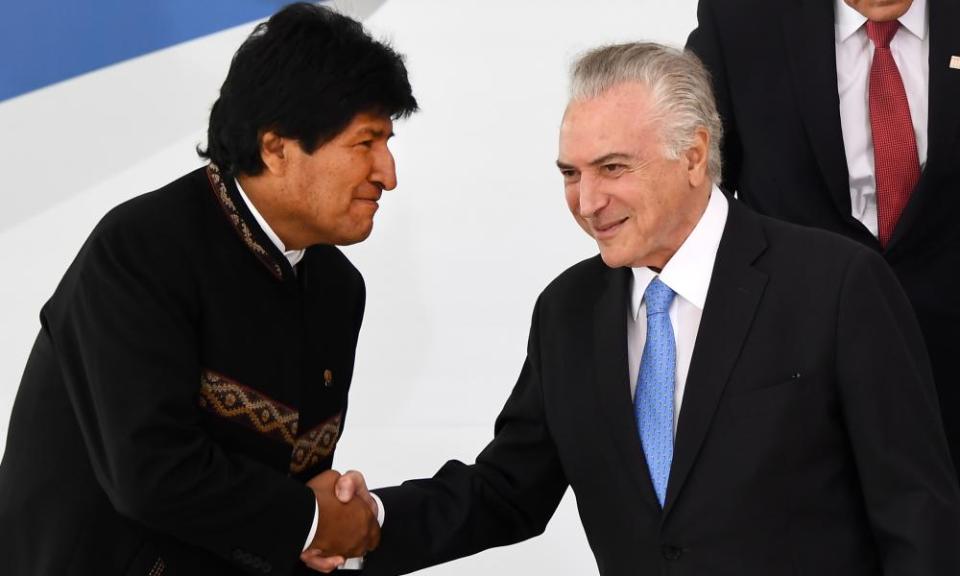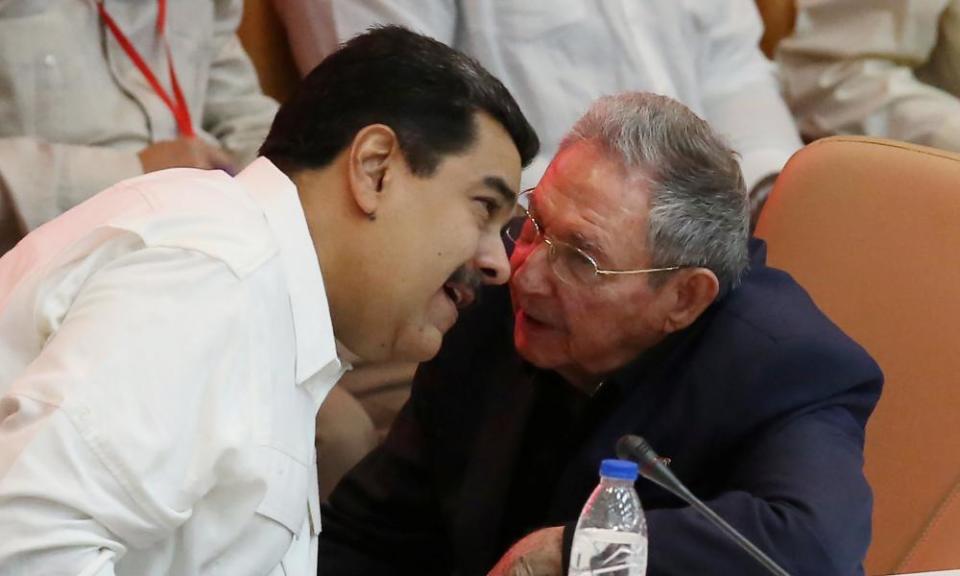Latin America voters likely to take stand against corruption as usual in 2018
Brazil, Colombia, Mexico, Venezuela, Costa Rica and Paraguay face elections and may experience an anti-establishment tide that defies notions of left and right

The anti-establishment tide that has swept much of the world is set to break over Latin America in 2018. Some 350 million voters are due to head to the polls in Brazil, Colombia, Mexico, Venezuela, Costa Rica and Paraguay to elect new presidents – and in several cases, potentially slam a defibrillator into their ailing political systems.
“Attempting to understand or interpret the elections for what they mean in a left-right swing would be a mistake,” said Christopher Sabatini, a Latin America expert at Columbia University. “What we are more likely to see is more popular reaction against corruption.”
Seizing the headlines in July will be Mexico, where Andrés Manuel López Obrador, the perennial candidate of the left, will face off against José Antonio Meade, the technocratic successor to Enrique Peña Nieto. Few will miss the incumbent, whose term of office has been stained by a failure to rein in the country’s soaring murder rate, and pervasive corruption – in which the presidential couple themselves have been implicated.
While López Obrador, 64, a former mayor of Mexico City, is not as radical as his detractors claim, his promises to tackle graft and poverty have won him a 5 to 15% poll lead over his rivals. Yet López Obrador’s own missteps – such as suggesting an amnesty for criminals – and fear of change may see voters plump for business as usual.
Brazil’s Michel Temer, meanwhile, probably views even Peña Nieto’s meagre ratings with envy. Temer – a rightwing 77-year-old career politician who helped remove Dilma Rousseff in last year’s controversial impeachment – has seen his approval ratings drop as low as 3% amid widespread allegations of corruption which have at times seemed to implicate Brazil’s entire political class.
The beneficiary in October’s presidential race is likely to be the former leftwing president Luiz Inácio Lula da Silva, currently polling at around 36% – although he too faces corruption charges that could bar him from running. Meanwhile, the far-right homophobe Jair Bolsonaro (on 15%) is gaining strength despite – or perhaps because of – his enthusiasm for Brazil’s military dictatorship.
“Whoever can present himself or herself as the cleaner, less tainted candidate will be likely to win in Brazil and Mexico,” said Sabatini.
Across Latin America, voters will be led not by ideology but issues – such as the demand for cleaner government, rejection of entrenched political groups – or, in Colombia, concerns over the peace process with the leftwing former rebels of the Farc.

In neighbouring Venezuela, some doubt whether presidential elections scheduled for December will even take place, especially after the embattled Nicolás Maduro threatened to ban major opposition parties. If allowed a free and fair ballot, Venezuela would probably opt for change. But a divided opposition has failed to convince enough people that they are a better proposal than hyperinflation, shortages of basic goods, and rampant crime.
Democracy will be in the crosshairs elsewhere. Bolivia’s Evo Morales, will probably press ahead with his plans to run for a fourth term in 2019 after compliant judges scrapped term limits. Here too, voters are increasingly disappointed with the incumbent, but have yet to find a viable alternative.
Nicaragua’s Daniel Ortega, president since 2007, will probably take steps to deepen his illiberal rule – and possibly pass even greater power to his wife (and vice-president) Rosario Murillo. Honduras could see greater turmoil after its December presidential election was marred by serious allegations of fraud by the rightwing incumbent, Juan Orlando Hernández. Cuban leader Raúl Castro will step down, but his departure is unlikely to bring political or economic change.
Even normally staid Chile faces an uncertain panorama. Centre-right businessman and former president Sebastian Piñera won December’s presidential election having suggested expelling all undocumented immigrants and played on fears of Venezuela-style chaos should his centre-left rival have won. But his second term in office will be harder than his first – opposition parties outnumber his coalition in congress, including the radical leftwing Frente Amplio coalition which rudely interrupted 30 years of two-party politics in November.
Yet for most people in Latin America, electoral politics will be low down on a long list of concerns. Across the region, economies will remain sluggish, jobs scarce and pay low.
Most pressing for many will be worries about corruption, security and crime. Despite eradication efforts, cultivation of coca – the raw material in cocaine – remains buoyant and cartels continue to operate with impunity across borders.
And beyond some experimentation with legalized marijuana, few politicians will put their head above the parapet to admit change is needed. The US-backed militarized war on drugs is likely to grind on in its main battlefields of Mexico, Colombia and Central America.
Why did Mexico launch its war on drugs?
On 10 December 2006, president Felipe Calderón, launched Mexico’s war on drugs by sending 6,500 troops into his home state of Michoacán, where rival cartels were engaged in tit-for-tat massacres.
Calderón declared war eight days after taking power – a move widely seen as an attempt to boost his own legitimacy after a bitterly contested election victory. Within two months, around 20,000 troops were involved in operations across the country.
What has the war cost so far?
The US has donated at least $1.5bn through the Merida Initiative since 2008, while Mexico has spent at least $54bn on security and defence since 2007. Critics say that this influx of cash has helped create an opaque security industry open to corruption at every level.
But the biggest costs have been human: since 2007, around 200,000 people have been murdered and more than 28,000 reported as disappeared. Human rights groups have also detailed a vast rise in human rights abuses by security forces.
As the cartels have fractured and diversified, other violent crimes such as kidnapping and extortion have also surged. In addition, hundreds of thousands of people have been displaced by violence.
What has been achieved?
Improved collaboration between the US and Mexico has resulted in numerous high-profile arrests and drug busts. Officials say 25 of the 37 drug traffickers on Calderón’s most-wanted list have been jailed, extradited to the US or killed, although not all of these actions have been independently corroborated.
The biggest victory – and most embarrassing blunder – under Peña Nieto’s leadership was the recapture, escape and another recapture of Joaquín “El Chapo” Guzmán, leader of the Sinaloa cartel.
While the crackdown and capture of kingpins has won praise from the media and US, it has done little to reduce the violence.
How is the US involved?
Mexico’s decade-long war on drugs would never have been possible without the huge injection of American cash and military cooperation under the Merida Initiative. The funds have continued to flow despite growing evidence of serious human rights violations.
Violence, impunity and cartel-backed corruption will keep driving people from Honduras, El Salvador and Guatemala, and enforcement efforts in Mexico and along the US border will force migrants to take increasingly dangerous routes in search of safety.
But the experience of most Latin Americans will be far from violence, struggle and poverty. The middle class will still grow, if not at the dizzying rate seen in the early years of the century. Tens of millions will be glued to the television during their lunchbreak as the region’s champions duke it out for World Cup glory in Russia.
And when the final whistle is sounded on 15 July, Colombia, Mexico, Paraguay and Costa Rica will have new presidents, while everything will still be for to play for in Brazil and Venezuela – for better or worse.

